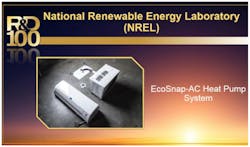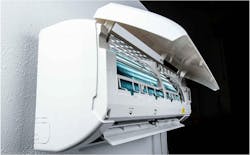Window air conditioners, or “window shakers” as they’re irreverently referred to, are perhaps the least popular of all HVAC equipment (I probably dislike PTACs even more than window units, since our firm sees so many of them in our work, especially in limited-service hotels). Why are window ACs so unpopular? They’re unattractive, inefficient, noisy, often unreliable, and difficult – if not impossible – to repair (most HVAC professionals consider them “throwaways”). They frequently leak condensate, nearly always allow air infiltration, and may often pose a security risk to the property in which they’re installed. They are, however, relatively inexpensive and easy to install (even by D-I-Yers), and so they have a definite niche.
Even thru-the-wall installations can be much less costly than a comparable split or mini-split system, which require professional installation. That’s why, in 2016, R&D Magazine – which has been honoring the 100 best research and development innovations each year for more than half a century – presented the R&D 100 Award to the National Renewable Energy Laboratory (NREL) for its EcoSnap-AC Heat Pump System.
The EcoSnap-AC is the brainchild of two senior engineers in NREL’s Building Energy Sciences group. Chuck Booten and Jon Winkler had been working on the EcoSnap-AC technology for three years when it won the R&D Award, and they have been working to improve it since. The concept is simple: to be able to easily and economically install a high-efficiency mini-split heat pump without cutting a large opening in the wall. While studying residential window air ACs, they became convinced that there was a better way to achieve inexpensive, high(er) efficiency, residential cooling.
Early in the development of their concept, the two Ph.D. researchers filed a provisional patent for the as yet unnamed technology. Then, in 2014, DOE launched the Lab-Corps program to help their researchers commercialize promising technologies. This led to the first hardware prototype, in 2015, cannibalized from existing equipment.
- To see the 2018 patent application, click here.
Booten and Winkler continue to improve their snap-together system, with the intention of eventually seeing them sold in big-box stores, where a consumer would take it home, drill a single hole in the wall, and mount the two pieces. They are currently seeking investors, grants, and additional NREL funding, and they have also reached out to the AC manufacturing space. In addition to the ease of installation, comfort, and improved aesthetics, the EcoSnap-AC will also save energy…another win-win innovation from a DOE national laboratory.
A regular contributor to HPAC Engineering and a member of its editorial advisory board, the author is a principal at Sustainable Performance Solutions LLC, a south Florida-based engineering firm focusing on energy and sustainability.
About the Author
Larry Clark
A member of HPAC Engineering’s Editorial Advisory Board, Lawrence (Larry) Clark, QCxP, GGP, LEED AP+, is principal of Sustainable Performance Solutions LLC, a South Florida-based engineering firm focused on energy and sustainability consulting. He has more than two dozen published articles on HVAC- and energy-related topics to his credit and frequently lectures on green-building best practices, central-energy-plant optimization, and demand-controlled ventilation.



